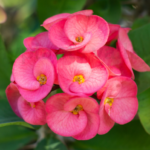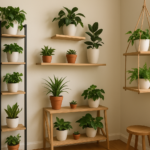Hoya crassipetiolata is a species of hoya plant known for its thick leaves and stout stems. This particular hoya is prized by plant enthusiasts for its unique and attractive foliage.
Hoya crassipetiolata, also known as the Thick-leaved Hoya, is a captivating houseplant that has gained popularity among indoor gardening enthusiasts. With its glossy, thick leaves and fragrant clusters of star-shaped flowers, this plant is a beautiful addition to any plant lover’s collection. However, caring for Hoya crassipetiolata requires some specific attention to ensure its health and vitality. In this beginner’s guide, we will explore the essential care tips and techniques to help you keep your Hoya plant thriving.
Get to Know Your Hoya crassipetiolata
Before diving into the care requirements, it’s essential to familiarize yourself with the characteristics of Hoya crassipetiolata. This succulent vine is native to Southeast Asia and belongs to the Apocynaceae family. It is known for its thick, waxy leaves that store water and allow the plant to withstand periods of drought. Its clusters of fragrant, star-shaped flowers can range in color from white to pink and emit a sweet aroma that fills the air.
Scientific name: Hoya crassipetiolata
Common name: Waxflower, waxplant, wax vine
Genus: Hoya
Family: Apocynaceae
Origin: South East Asia
Flower color: Star-shaped flowers are often fragrant and come in brilliant shades of red, pink, yellow, and more.
Soil: well-drained soil. Hoya hates clogged soil!
Light: full sun to partial shade
Watering: plenty, but(!) let it dry out between waterings
Hardiness: not lower than 14°C (57°F)
Height: Vine, up to 3m (9’9″)
Hoya crassipetiolata Care

Caring for Hoya crassipetiolata requires attention to its specific needs, but with the right knowledge and techniques, you can ensure its health and vitality. In this article, we will explore the essential care tips for Hoya crassipetiolata, helping you create optimal conditions for its growth and enjoyment.
Lighting Requirements
Proper lighting is crucial for the healthy growth of Hoya crassipetiolata. Place your plant near a north or east-facing window where it can receive bright, indirect light. Direct sunlight should be avoided, as it can scorch the leaves. Supplemental fluorescent or grow lights can be used if natural light is limited in your indoor space.
Watering and Humidity
Finding the right balance of watering is essential for Hoya crassipetiolata. Allow the top inch of soil to dry out before watering thoroughly, ensuring water drains out from the bottom of the pot. Overwatering can lead to root rot, so it’s important not to let the plant sit in excess water.
Hoya crassipetiolata appreciates higher humidity levels, so misting the leaves or placing a tray of water nearby can help maintain a humid environment.
Temperature and Environment
Hoya crassipetiolata thrives in temperatures between 60°F and 80°F (15°C to 27°C). Avoid exposing the plant to extreme temperature fluctuations, drafts, or cold air from air conditioning or heating vents. Moderate to high humidity is ideal for this tropical plant. Consider using a humidifier or placing the plant on a tray of water and pebbles to increase humidity levels if needed.
Soil and Fertilizer
Choosing the right soil mix is crucial for Hoya crassipetiolata’s well-being. A well-draining mix consisting of equal parts peat moss, perlite, and orchid bark replicates its natural habitat. This combination allows for adequate drainage while retaining some moisture.
Fertilize your plant with a balanced, water-soluble houseplant fertilizer diluted to half the recommended strength. Feed your plant every four to six weeks during the growing season, which typically spans from spring to early fall.
Pruning and Training
Pruning Hoya crassipetiolata serves several purposes, including maintaining its shape, removing dead or damaged leaves, and encouraging fuller growth. You can prune the plant after flowering or when necessary. Use clean, sharp pruning shears to make clean cuts just above a node or leaf joint. You can also train the vines to grow in a particular direction or along a trellis by gently guiding them with plant ties or clips. Pruning and training not only help manage the plant’s size but also enhance its aesthetic appeal.
Propagation Of Hoya crassipetiolata
Propagating is an exciting way to expand your plant collection or share it with fellow plant enthusiasts. One common method of propagation is through stem cuttings. Select a healthy stem with at least two nodes, make a clean cut just below a node, and remove any lower leaves. Allow the cutting to dry and callous for a day or two before placing it in a well-draining mix. Keep the cutting warm and lightly moist, and roots should develop within a few weeks. Another method is through leaf cuttings or layering, which involve different techniques and may require more time and patience.
Common Pests and Diseases
Like Hoya Sunrise, Hoya crassipetiolata is susceptible to pests and diseases. Common pests include mealybugs, spider mites, and aphids. Regularly inspect your plant for signs of infestation and take appropriate measures to address them. Preventive measures such as regular cleaning, maintaining proper humidity, and providing good air circulation can help keep pests and diseases at bay.
Troubleshooting Common Issues
Sometimes, despite your best efforts, issues may arise with your Hoya crassipetiolata. Leaf discoloration, wilting, or poor growth could indicate various problems. Diagnosing the issue correctly is crucial for implementing the right solution. Common issues may include overwatering, nutrient deficiencies, or incorrect lighting. By identifying and addressing these issues promptly, you can get your plant back on track to thriving.
Frequently Asked Questions
What Is Hoya Crassipetiolata?
Hoya crassipetiolata is a species of flowering plant in the family Apocynaceae. It is native to southeast Asia and is commonly known as the wax plant. It is known for its pretty clusters of star-shaped flowers and its thick, succulent leaves.
How Do I Care For Hoya Crassipetiolata?
To care for hoya crassipetiolata, place it in bright indirect light, water it when the top inch of soil is dry, and use well-draining soil. It prefers slightly warmer temperatures and moderate humidity levels. Additionally, fertilize it during the growing season and trim it to maintain its shape.
What Are The Benefits Of Having Hoya Crassipetiolata?
It can bring various benefits to your space. It not only adds beauty with its unique flowers and glossy leaves, but it also helps purify the air by removing toxins and releasing oxygen.
Can Hoya Crassipetiolata Be Grown Outdoors?
Hoya crassipetiolata is primarily grown as an indoor houseplant, but it can also be grown outdoors in regions with tropical or subtropical climates. If grown outdoors, it should be placed in a location that receives bright but indirect sunlight, protected from extreme weather conditions.
How Often Does Hoya Crassipetiolata Bloom?
It typically blooms once a year during its growing season, which is usually in the summer or early fall. The exact timing and frequency of blooming may vary depending on factors such as the plant’s age, growing conditions, and care provided.
Patience and proper care will encourage blooming.
Conclusion
Caring for Hoya crassipetiolata requires attention to detail, but the rewards are well worth it. By understanding its specific needs and providing the right conditions of light, water, temperature, and soil, you can cultivate a thriving plant that will grace your indoor garden with its beauty and fragrance. Remember to monitor your plant closely, adjust care as needed, and enjoy the journey of nurturing your plant into a flourishing masterpiece.
Incorporating the right care practices will ensure the success of your Hoya crassipetiolata. So, follow the guidelines outlined in this comprehensive guide, and watch as your hoya plant thrives, becoming a stunning centerpiece in your indoor garden.







